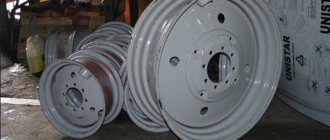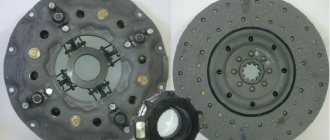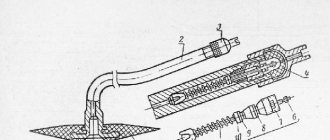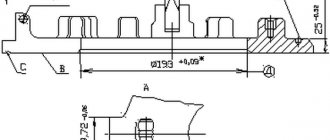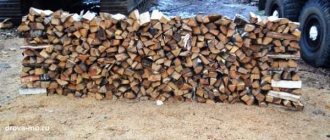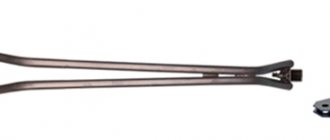Commercial vehicles have long become an integral part of the life of many small enterprises throughout Russia, which is associated with rising tariffs for cargo transportation and other economic factors. In addition, in almost all regions of the country, the business associated with transporting passengers by minibuses - the so-called minibuses - is constantly gaining momentum. Most of such activities are carried out using commercial vehicles of the famous domestic brand “GAZ”, and this car is popularly called “GAZelle”.
All tires on GAZelle have a strict classification depending on the model’s configuration, the load or passenger capacity of the body, operating conditions and other factors. Considering that the Nizhny Novgorod brand began producing the first modifications of the GAZelle back in 1994, which are still in demand, over the entire period there have been several generations of the car, presented in dozens of different modifications, and the most popular tire sizes are given below:
Tires for passenger GAZelle
- The simplest configuration of the brand was shod with tires with dimensions 185/75/R16С, with a mandatory condition to ensure increased load capacity - the load index must be at least 96, that is, the tire in the inflated state had to withstand a load of 710 kg or in terms of weight car with a standard wheelbase with 2 axles - 2.84 tons. The wheel size on the GAZelle in the basic configuration is exactly the same as given above for 80% of the copies.
- Also on the market you can see versions with thinner stamped wheels of 175 mm, which help improve the dynamics of the car, but limit its operation only on asphalt roads.
- In all-wheel drive versions (4x4), designed to overcome difficult road conditions, GAZelle tires are installed with a wider sole, 195 mm, and the increased contact area with the ground helps the car exert less pressure and, accordingly, overcome sticky soil or loose snow faster .
The index “C” after the tire size marking means that the tire is manufactured for trucks. Despite the fact that many tires for passenger cars can have a load index of 96 or higher, it is better for GAZelle owners not to use them without the “C” marking. This is due to the structural features of the sole layers, the strength of the side part (profile) of the rubber and the manufacturing technology of the product. It is quite easy to distinguish a truck tire from a passenger tire, since they usually have a larger mass due to the increased number of layers.
Reinforced tires for the GAZelle truck
Car tire rating for Gazelle
Almost every global tire brand produces tires whose parameters are suitable for the GAZelle, since this car has many competitors from among foreign commercial vehicles. However, often the budget of the owners of this car does not allow drivers to install any tires, since their cost marked “C” can reach 20 thousand or more rubles. for each wheel. Therefore, below is a rating of tires for GAZelle, indicating the average cost of each product as of February 2019:
- Domestic tires with model 301 have gained the most popularity, since these products combine all-season properties, increased grip on the road surface in any weather, rubber compound technology developed over the years increases wear resistance, and manufacturing technology ensures maximum rigidity of the frame. With all its positive properties, this tire will cost the driver no more than 2.9 - 3.3 thousand rubles. for each wheel.
The one and a half ton Gazelles of the delivery class, which rolled off the AvtoGaz assembly line in 1994, made a real revolution in small cargo transportation, filling a niche for small and medium-sized businesses that were developing in those years, almost completely displacing foreign cars of this class, due to their low cost and greater adaptability to Russian off-road.
FAQ
The GAZ Gazelles family has grown to several hundred modifications and versions, including the latest Gazelle Next, Gazelle Business and even an electric minibus.
Over 24 years, more than 2 million of these vehicles have been produced, including Gazelle 3302, Gazelle 2705, Gazelle Farmer and others, more than half of which work in the CIS, and some abroad.
Interested amateurs and drivers starting their careers often ask questions on the World Wide Web or on forums, including:
- What size tires are on the Gazelle?
- Tire size for Gazelle 3302.
- What is the tire size for Gazelle Next.
- What models are suitable for tires size 185/75 p16 for Gazelle.
- Tires size 185/75 for Gazelle - which ones are better to buy.
You will now find out the answers to these and many other questions related to the topic of tire size for GAZ Gazelles.
Tube or tubeless
It is better to install tube tires on light-duty trucks, although tubeless ones are cheaper and practically do not differ in quality. Therefore, car owners of Gazelle Next diesel (or with another engine) decide whether to install tubed or tubeless tires individually.
Tube and tubeless tire
Tire standards for GAZ Gazelle
AvtoGAZ recommends two types of tire sizes for Gazelles on both axles - 175R16C and 185/75R16C, where 185 is the width in mm, 75 profile is also in mm, and R16 is the tire size. Index C means light truck type. At first, the Gazelle was equipped with 175R16C tube tires as standard, and only then 185/75R16C tires began to be used.
On the Barguzin and Sobol models with a lower load capacity, 215/65R16 tires were initially installed, but later they were replaced by 195/75 R16 and 205/70 R16. In fact, since these cars have wider rims and do not have twin rear wheels, the tire size on them can vary from 185/75 to 245/60.
The factory equipment on the Gazelle Next consists of 185/75 R16C tires, but during tuning they also install 175/80 R16C.
The recommended tire load capacity index is from 96/98 to 102/104, where the first value is for two sloping wheels, and the second, respectively, for single-pitch wheels and means the permissible load. So index 102 determines the load at 0.85 tons, and 104 at 0.9 tons.
Since Gazelles generally have two paired wheels at the rear, the load on them can reach up to 2 tons (0.9*2+0.85*4) when equipped with tires with index 102/104 5.2. With a total weight of 3.5 tons and a limited load of one and a half tons, there remains a reserve of 2 centners for tires. However, it is common knowledge that cargo Gazelles are operated under significant overload, but the tires can usually withstand this.
For installation on the Gazelle, “rubber” from “Niva” may be suitable. At the end of the 90s of the last century, with an insufficient choice of tires, or even simply a lack of necessary tires, Gazelle drivers sometimes installed VLI-5 off-road tires.
Currently, the situation has changed dramatically, but even now there is production of tires, for example, K-156, VLI-10M, designed for Niva with a reduced load capacity index, but increased in speed, and for Gazelle with the opposite index value (higher lifting capacity, but lower speed).
Important! It is unacceptable to install used tires on the Gazelle, since in real Russian conditions, off-road driving with overload is more the norm than a deviation from the rules. Even if the tires look good on the outside, they probably have internal damage.
Only for Barguzin and Sobol such an acquisition is possible with a probability of a favorable outcome of no more than 50%; for the rest of the Gazelles, including Gazelle Next, Gazelle Business, this is a game of Russian roulette.
Tips for choosing a tire
Low-profile tires provide ride comfort, planning and reduced rut feel, but at the same time the ease of driving is reduced.
Characteristics of the distance of gazelle disks
The lower the profile, the heavier the wheel due to the enlarged disk, which is much heavier than the tire. Due to this, the moment of inertia of the car increases due to the distribution of the weight of the wheel to its outer edge, although this is of little significance for cars with a sufficiently powerful engine. If the wheel diameter changes significantly, problems may arise with the clarity of instrument readings in the car, including speed.
Tire seasonality
According to the experience of many Gazelle drivers, it is optimal to choose all-season tires. This allows you to reduce the cost of tire fitting and choosing places to store the second set. This is dictated by the following reasons:
- number of wheels - not 4, but 6;
- difficulty changing rear wheels;
- additional costs for purchasing and storing an additional pair.
A set of new winter tires for a Gazelle truck
Based on the fact that there are 6 wheels, and the optimal number in a stack for storage, in a place adapted for this purpose, is 5, you will have to either pay additionally or find a place to install the sixth wheel for storage.
Manufacturers in the off-season - late autumn or spring - prefer to offer drivers tires that correspond to more winter options, with studs, or more summer treads.
It is worth noting that summer tires are less noisy, while winter tires are more suitable for winter Russian roads. But everyone chooses for themselves. Here are the main marks on rubber to determine their seasonality, which are traditionally written in English. They are as follows:
- Snow+mud, which means snow and mud. That is, the tires are designed for traveling on slushy, finely snow-covered roads. Their pattern is specially made for such weather.
- All-season or Any (All) season, A, G, T, AS, AW - tires suitable for all climatic conditions are designated.
- An umbrella or an inscription denoting rain (rain), water (aqua, water) ensures the safety of a trip in conditions of high water levels on the road, that is, it creates the invisibility of water as an obstacle between the wheels and the road.
- Snowflake or winter designation - clearly indicates the season of use of these tires.
Review of tire manufacturers for GAZ Gazelle
There are offers to “shoe” the GAZ Gazelle “sea,” as they say, for every taste and color, both from domestic manufacturers GAZ, Amtel, Cordiant, Volgograd and Altai tire plants, and from the most famous foreign companies Michelin, Bridgestone, Goodyear and so on. Not long ago, Chinese tires Aeolus, Triangle and Boto joined the competition.
There is no doubt that the quality of Western tires is incomparably higher than domestic ones, but in terms of price the Russians are already winning. Thus, prices for domestic products “spin” around 3 thousand rubles, and prices, for example, for Michelin are at least 1/3, or even 2 times more expensive.
Consequently, the main criterion is the price-quality ratio and the specific conditions of the area where this Gazelle will have to work hard, since of course the wear of the same Michelin under normal conditions is less than that of the K-135, but in non-standard situations for them, which also are repeated continuously, it becomes equal.
Most of our manufacturers, and even Gazelle operators, prefer all-season tires. This is significantly cheaper, and Gazelles are basically cargo vehicles with dual rear wheels. But studded tires are also produced, and more and more Gazelle owners are choosing a safer and more comfortable ride with ultimate savings in the service life of both summer and winter tire sets, at significant initial costs.
Good studded tires are supplied by Western manufacturers, as well as good studded tires from the Volzhsky Omsk plant (brands VS-21, VS-22 and O-110, O-160, respectively).
As before, at least 2/3 of Gazelles are shod with tube tires, citing the poor quality of wheel rims and roads. But the situation is gradually improving with disks and even with roads. Considering this, as well as the fact that tubeless tires are more practical and cheaper, in general only a fifth of Russian trucks use tube tires.
The GAZelle car is used for freight and passenger transportation. Therefore, the use of high-quality, reliable tires that provide good handling is strictly necessary. It is only important to choose the correct wheel size. Tires for GAZelle can be divided into two main categories: standard and non-standard.
ATTENTION! A completely simple way to reduce fuel consumption has been found! Don't believe me? An auto mechanic with 15 years of experience also didn’t believe it until he tried it. And now he saves 35,000 rubles a year on gasoline!
The tire size depends on many factors: wheel formula, year of manufacture, engine modification. A relatively old model is the GAZ-2705. It has a 4×2 wheel arrangement. Hub diameter – 130 mm. Standard wheel parameters:
- tire modification – 185/75 16C;
- disk size – 5.5J×16 ET106;
- drilling – 6×170 mm.
For vehicles with a 4×4 wheel arrangement, the tire size is slightly different. The width of the “sole” should be slightly larger. This is a prerequisite for normal contact between the wheel and the road. Standard wheels for a GAZ-3221 car with a 4×2 wheel arrangement:
- hub diameter – 130 mm;
- type of disk used – 5.5J×16 ET106;
- tire – 195/75 mm.
There are 7 different versions of the GAZelle car. The latest modification is a machine labeled Next. It has a 4×2 wheel arrangement and the following main characteristics:
- tire – 185/75 mm;
- disk – 5.5J×16 ET106;
- drilling – 6×170 mm.
Using wheels that meet standard parameters will make the car more controllable and avoid premature wear of chassis parts. There are many different subtleties and features of choosing wheels. If you do not have sufficient experience, you should use the help of specialists.
Rubber manufacturers
Tires for light trucks are represented on the market by almost all factories producing them in Russia. For factory equipment, tires produced by the Yaroslavl plant under the Y462 brand are more often used. The following brands also exist:
- Nizhnekamsk - Kama -218 or 301;
- Volzhsky - VS-22, VL - 54;
- Omsk - MPS - 115, O - 147;
- Kirovsky - K - 139/156/170, called “Barguzin”;
- Bobruisk - BI - 522;
- Ural - K-135;
- Altaisky - A-12 Forward Professional.
What non-standard sizes can be supplied?
The most common wheel size is 185/75 P16. However, many vehicle owners install tires whose size differs from those recommended by the vehicle manufacturer. When choosing tires, you must first consider the following points:
- tire diameter size is the main parameter; wheels with a diameter of up to 21 inches can be installed (but some modification is required);
- profile width - this indicator allows you to determine the size of the contact patch between the wheel and the rubber (it is advisable to use wheels with parameters from 175 to 215 mm);
- profile height is a parameter that determines the value between the disk and the coupling spot (a dimension from 75 mm to 85 mm is considered acceptable).
It is necessary to familiarize yourself in advance with all the subtleties and nuances of choosing wheels. Since the use of tires whose dimensions are too large can cause serious problems:
- wheels that are too large in diameter or width touch the plastic fender liners - which leads to their damage and the need for replacement;
- there is a high probability of damage to the mudguards - the cost of the kit can reach several thousand rubles.
An important point is the profile height. Moreover, if the car is used for freight transportation, it is advisable to use tires with a parameter of 85 mm. This will avoid problems during transportation and make the car more manageable.
If for some reason the owner cannot choose the right tires on his own, it is worth stopping at 185/75 r16c. Their price is relatively low.
What is the tire pressure
One of the main responsibilities of car owners is to constantly monitor tire pressure levels. It should not be less or more than nominal. You can familiarize yourself with the standard characteristics recommended by the manufacturer. There is a metal nameplate under the hood, in the area where the engine is located, or on the door pillar. It contains detailed information about the standard size of permissible wheels, their diameter and permitted pressure.
Some drivers deliberately operate their vehicle with wheels whose tire pressure is less than the nominal pressure. In this way, it is possible to achieve a smoother movement of the car over bumps. However, low blood pressure causes a number of different problems:
- significantly increases fuel consumption - by 5-15% of the original value;
- the side “soles” of the wheel wear down much faster;
- the car handles much worse;
- on the front axle – 3.8 kPa;
- on the rear axle – 3.9 kPa;
- spare wheel - 3.9 kPa.
The standard wheels installed on these cars are tubeless, they are equipped with stamped discs. In this case, the axis has a paired “two”. The maximum speed of the car is 110 km/h. Therefore, you can not be afraid to choose among the cheapest tire options.
Review of the best summer and winter tires
Many owners purchase so-called “all-season” tires. However, the disadvantage of such wheels is the lack of studs and poor contact with the road on ice. The best solution is to purchase separate sets of tires for winter and summer. This will avoid problems on the road.
Michelin Agilis+ are distinguished by their durability and relatively low price - despite their overall size. They will be an excellent solution for GAZelle car owners.
Nexen WG WH2 will cost extremely cheap - no more than 3,500 rubles for 1 cylinder. Despite the relatively high cost, such wheels are durable and perfectly remove water from the contact patch.
The Firestone Touring FS100 is made from quality rubber. The manufacturer uses an electronic control method.
Yokohama AE01 Bluearth allows the driver to feel 100% safe even on wet roads. The presence of special drainage channels ensures excellent contact between the “sole” of the wheel and the road surface.
The Cordiant Comfort company offers good summer solutions. The rubber produced by this company is distinguished by its durability. It is extremely difficult to damage it even with a special one.
You should be especially careful when choosing winter tires. By Pirelli Winter Formula ICE features a large number of steel studs. Their presence allows you to create reliable contact.
Nokian HKPL-8 is a great solution for a frosty winter! The presence of spikes and a large number of drainage channels in the wheel base helps to avoid aquaplaning. The car handles all turns perfectly.
Dunlop Winter ICE-02 91T has an unusual tread shape. The use of such rubber allows you to safely move on roads of any quality. Reinforced sidewalls will help avoid damage to the wheel when hitting curbs or other obstacles.
Bridgestone Spike-02 is relatively inexpensive. In this case, the total number of studs on 1 wheel is about 250 pieces.
The price for one Nexen Winguard Spike tire will be approximately 4,300 rubles. Despite the relatively low cost, such tires perform well on the most difficult roads. The presence of ice and water will not cause any inconvenience to the driver. There are several standard sizes in the series.
It is necessary to familiarize yourself with all the parameters of the tire before purchasing it. This is the only way to avoid purchasing wheels of the wrong type. High-quality tires are the key to driver safety on the road.
Such a seemingly simple question about the size of tires and wheels can have many nuances. Of course, the wheels on the GAZelle have their standard dimensions set by the manufacturer. At the same time, there are a large number of questions on this topic that complicate the choice of tires and wheels for car owners.
This article will consider both the standard sizes of tires and wheels for the GAZelle, as well as various issues related to the selection and installation of wheels. How can changing the size of a tire or wheel affect the way you drive? Which tire is better? Does it make sense to install a cast one or leave the factory stamped ones? We will look for answers to these and other questions together.
Factory sizes of tires and wheels for GAZelle
GAZelle wheels, the size of which does not differ from standard ones, are produced by many manufacturers. The tires for them are marked 185/75 R16 C. And what’s interesting is that for all medium-tonnage cars of the GAZ group, including Sobol, this size will be suitable. And if GAZelle must adhere to this particular option, then for Sobol there is another option - 215/65 R16.
As for the standard size - 16, that is, GAZelle wheels with a 16th radius are used. But the fact is that when selecting and purchasing wheels, this information is not enough. There are a number of parameters that need to be maintained:
- wheel offset - ET=106 mm;
- diameter of the central hole - 130 mm;
- number of mounting holes - 6;
- the distance between the mounting holes is 170 mm.
The weight of a standard factory wheel for a GAZelle is 12.8 kg. It can withstand a maximum load of 720 kg.
Reviews
Motorists' opinions on the selection of tires for Gazelle. Maxim Ivanov.
I drive on original size tires. I tried to put 215 on the front, for the rear axle I used 195. The experiments ended after I got stuck in an ordinary puddle. Dmitry Komshchenko.
I put 195 tires on the twin pair, they don’t wear out under load, I loaded 3 tons - everything is fine. There are currently 205 tires on the front end. I left stock two years ago. Author of the material: Borisov Maxim
Sources:
- shina-gear.com
- kolesnyigid.ru
- kolesospec.ru
- rus-avtomir.ru
A little theory about wheel sizes
To make it clearer, let’s look at what stands behind the numbers in the description of wheel and rim sizes.
For example, 185/75 R16 C means that the wheel diameter, that is, the inner diameter of the tire is 16 inches, the tire type is radial (R), the section width is 185 mm, and the section height to width ratio is 75%. The letter “C” means a reinforced version of the tire used for minibuses and trucks.
Knowing all these parameters, you can easily select the necessary wheels for a GAZelle, the size of which is known. If you want to experiment and take a wheel of increased diameter or width, you need to use “tire” calculators or consult a specialist.
Now let’s look at the wheels on the GAZelle and their markings, which look like this: 5.5Jx16 ET106 PCD 6/170 d 130. The first and second numbers are the width and diameter of the wheel in inches, that is, for the GAZelle it is 5.5 and 16 , respectively. Disk offset is a characteristic showing the distance from the landing plane to the plane passing through the middle of the disk width.
“GAZelle” and “GAZelle-Next”: is there a difference in wheel installation
It is known that several cars are hiding under the name “Gazelle”. These are the all-metal GAZ-2705, the flatbed GAZ-3302 and the minibus GAZ-3221. All varieties of these cars can have the same wheels with the standard sizes indicated above.
Wheels on the GAZelle 185 75 R16C are also installed on all Next varieties. This includes all onboard modifications, variants and frame buses.
The same picture applies to disks. The only caveat: with the advent of the GAZelle-Next version, the standard wheels were modified, and now all variants are equipped with reinforced parts originally developed for Next.
Disc weight
The weight of wheels for a Gazelle car depends on the size. As it increases, so does the weight. The heaviest ones are definitely the boiled and enhanced ones. In the first case, the mass increases due to welded additional parts. And in the second case, the thickness of the reinforced wheel significantly exceeds the thickness of the usual one, and the weight increases accordingly.
A 16-inch product for a regular Gazelle has a total weight of 14.9 kilograms. The model, built on the basis of the Gazelle and called Sobol, has a wheel weighing 15.5 kilograms.
Tires for GAZelle
As already mentioned, the size of the wheels on a GAZelle truck is no different from the size of the wheels on a minibus. There are a large number of manufacturers producing tires in size 185/75 R16. It should be noted that at the factory, cars are most often equipped with either Kirov Amtel tires or products from Pirelli.
Among analogues of Russian production, you can most often find tires of the Kama brand. These are models as well as “Kama-Euro-131”. Among other manufacturers, they most often stand out for their low price tag. At the same time, the quality of the rubber remains at a sufficient level. Cordiant tires are pleased with their good performance and have an excellent price-quality ratio.
As for foreign analogues, there are much more options here, and wheels for GAZelle 185 75 R16C are often found. But it is also more difficult to recommend any specific model. Of course, the quality of such leaders as Michelin or Nokian is difficult to underestimate, but we should not forget about fakes. In addition, well-deserved brands have a completely different price tag. For example: if a Kama is sold for 2,800 rubles per wheel, then the same Michelin will cost 7,300 rubles.
Among the well-known and trusted foreign manufacturers are the following:
- Toyo;
- Yokohama;
- Hankook;
- Pirelli
- Goodyear;
- Michelin.
Popular tire models for Gazelle
Kama – Euro
For Russia this is the most popular model. It is characterized by good maneuverability on snowy surfaces, but behaves poorly on ice. It becomes stiff and loses elasticity below 15 degrees below zero. Many car enthusiasts complain about the studs flying out of their tires, and over time they deflate.
Tigar CargoSpeed Winter
According to gazellists, Tigar is the best model. The rubber is soft, so it will absorb potholes and small holes on the roads without any problems. The price is affordable, but unlike the Kama, it retains its thorns better and lasts longer. Pairs perfectly with urban use. It rides satisfactorily on snow and ice.
Gislaved Nord Frost Van
Lots of positive qualities. The rubber is soft and quiet, even in severe frosts. Good handling on snowy roads and in icy conditions, but due to their softness they lose a lot of studs. These tires are designed for stress-free driving.
Selecting wheels for GAZelle
Knowing the basic parameters of the wheels, to make a choice it is enough to decide on the design and manufacturer. Among the wide variety of products, when it comes to wheels, there are three main groups:
- stamped;
- casting;
- forged.
True, if we mean wheels for a GAZelle, the size of which does not differ from the standard ones, then the choice will be limited only to stamped products, and therefore will only be from manufacturers.
The advantages of ordinary iron discs over casting are that when struck there is no coloring, but only bending. Where a hole in the road leads the car to replace the alloy wheel, the GAZelle will move on, stopping at a tire repair shop for straightening.
From a large selection of manufacturers, we can highlight standard wheels produced by the Gorky Automobile Plant and non-original ones. Among the latter, Eurodiscs and products produced by the Kremenchug plant are very popular. There are also reinforced discs with a calculated load of up to 1,100 kg. Such wheels are preferred by car owners who regularly transport heavy loads.
Features of selection and installation
What to do if you want to change the radius of the wheels on a GAZelle? Let's say, if the standard tires are sixteenth radius, is it possible to install a 17th radius? Unfortunately, such tricks are not provided for GAZelles. You can only install a slightly wider wheel - 215/65 R16, but in return you get less controllability and faster wear.
As for installing disks with other parameters, the field for experimentation here is also small. The rigid characteristic is the number of holes for the studs (6) and the distance between them (170). In principle, you can take a disk with a large central hole diameter and use it during installation. You can also play a little with the flight. However, in practice, there is usually a large selection of wheels with standard characteristics for wheels on the GAZelle R16. Therefore, you don’t have to think long about the selection.
I would also like to note the possibility of changing all-season tires to ones more suitable for use. In this case, additional concern arises about the alternate storage of a set of six wheels, as well as the time spent on changing shoes. But there is also a positive aspect of winter tires - safer driving.
Additional seasonal markings
In accordance with many years of experience in operating cargo gazelles, drivers prefer to equip the vehicle with all-season tires. This decision is interpreted as a desire to save money on seasonal tire fitting, and the lack of space to store a second set of tires. The rear wheels are difficult to mount, since there are 4 of them.
Seasonal marking has the following designations characterizing the season and operating conditions:
- "M+S". Tires with a tread pattern for effective movement in mud and snow. They have a ground grip. These wheels for the Gazelle can be all-season or winter. If the marking does not include a snowflake design, then it is not recommended to use the tires in winter, only in summer.
- AS, AGT - all-season models.
- AW – for use in all weather conditions.
- Winter, snowflake pictogram - tires for the winter period.
- Aqua, Rain, Water or umbrella images - tires are designed to effectively drive on roads covered with water. Due to a specific tread pattern, water is drained away from the area where the tire contacts the road. At the same time, the maximum possible adhesion of the wheel to the road surface is maintained to ensure safe vehicle control.
- Studless - winter tires that are not subject to studs.
- Studdable - winter tires with studs or the possibility of such.
